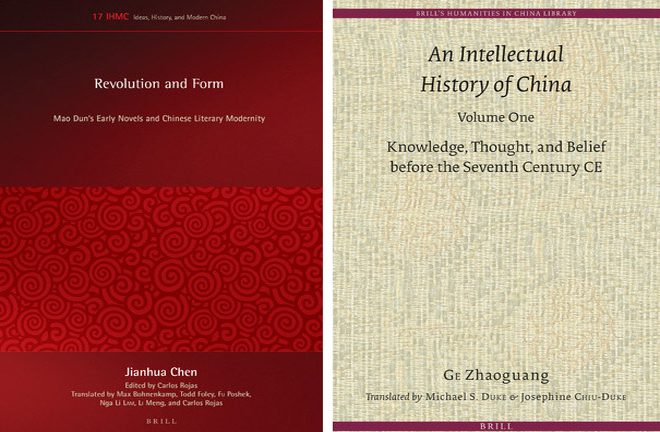Academic works need good-quality translation to go global

The English versions of An Intellectual History of China and Revolution and Form Photo: FILE
At present, Chinese publishers often find translators through bidding, but the responsibility of being “linguistic mediator” often falls to translators who know little about the original works. Translation sometimes becomes a stripped-down operation due to lack of time, resulting in frequent errors and low quality. Therefore, foreign readers show little interest when excellent Chinese books have been translated.
A book translation is a collaborative process between author and translator. Ge Jianxiong, a professor from the Institute of Historical Geography at Fudan University in Shanghai, said that China’s academic achievements will have little influence if they are not well translated. “In 1980, Chinese writer Shen Congwen’s visit to the United States made such a splash that some readers followed Shen’s itinerary from the East Coast to the West Coast. In fact, American sinologist Hans Frankel helped translate many of Shen’s answers, which fascinated audiences. The importance of translation is self-evident,” Ge said.
Indeed, it is demanding work to convert texts with cultural implications and aesthetic concepts into another language. Interpretation of ideas and transmission of academic opinions are particularly difficult. Accuracy, or even strict equivalence, is required.
In 2005, Brill launched the Contemporary China Research and Publication Program, aiming to promote two major series of Chinese academic books through translation and publication. The two series were “The Brill Collection of Chinese Humanities” and “Thinking, History and Modern China.” In 2008, the scholarly publisher acquired the copyright of the English version of An Intellectual History of China. The publishing team adopted peer review and quality supervision throughout the translation process. Ge repeatedly communicated with the two translators, and in some cases, they discussed a single chapter more than 40 times. The work’s Chinese text is 1,300 pages long. The book was finally reduced to 660 pages after many deletions were made to adapt to English readers. After eight years of hard work, the translated edition is satisfactory. An Intellectual History of China was collected by the most important academic institutions and famous libraries in the West. Also, it won the 2014 Best Academic Book Award by Choice Magazine, which is the sign of a good overseas reputation.
“My biggest thanks would go to the two translators for their great efforts over those eight years. We didn’t know each other before, but we are very good friends now. I think in the English version, the author is secondary while translators play a big part,” Ge Zhaoguang said at the forum. The target readers for An Intellectual History of China are not beginners, but people with certain academic backgrounds. Therefore, Ge has cited complicated historical materials and included many sophisticated expositions. The difficulty of transcoding them into English is clear.
Ge had previously encountered issues of unsatisfactory translation. An Intellectual History of China was translated as early as 2000, but the translated text was confusing. During the translation of another of Ge’s books, one translator even copied an entire section that he had casually searched online. This was ridiculous. “What matters most is to find the right translator,” Ge said.
Chen Jianhua, a professor and the author of Revolution and Form, agreed that some luck is required to find the right translators. “In the United States, one can read a wide range of academic works translated from French and German. Chinese scholarly books, however, require a period of cognition and transformation in which cultural and contextual obstacles can be overcome,” Chen said.
Wu Guanjun, editor-in-chief of the English version of the Journal of East China Normal University, expressed his opinion about academic translation, saying that “I’m not very anxious about the translation of academic books concerning the social sciences, but such work really worries me when it comes to literature, history and philosophy. We can say that translated books are new works because of different target readers. This is not a switch between languages, but a profound collision between two different discourse configurations. So, there will never be a best translation. We must find a way to make the impossible possible.”
Wu felt the work urgent. “A large number of outstanding Chinese scholars have vast learning, but in the era of globalization, Chinese thinking has yet to achieve its proper position. This prejudice should be changed. In fact, from a bigger perspective, Chinese thinking is valuable to increasingly homogenized Western thinking because it can bring ‘negative entropy’ to the global academic circle,” Wu said. Effective dissemination is indispensable for Chinese academics to have a role to play in the world.
Ge Jianxiong pointed out that it is necessary to separate the need to expand the influence of Chinese stories from the need to demonstrate academic strength, noting that “Academic strength does not mean large circulation. We must keep a cool head so that we can use funds wisely and so authors and translators can spend their energy properly. The book suitable for translation doesn’t necessarily have the most academic strength. Different translations serve different demands.”
Yan Feng, secretary of the Party Committee and chairman of Fudan University Press, believes that high-level original academic works are an important prerequisite for copyright output. State support guarantees Chinese academics will go global. High-quality translation is a key element to get Chinese academic books published into foreign languages.
This article was translated from Guangming Daily.
edited by MA YUHONG

 PRINT
PRINT CLOSE
CLOSE